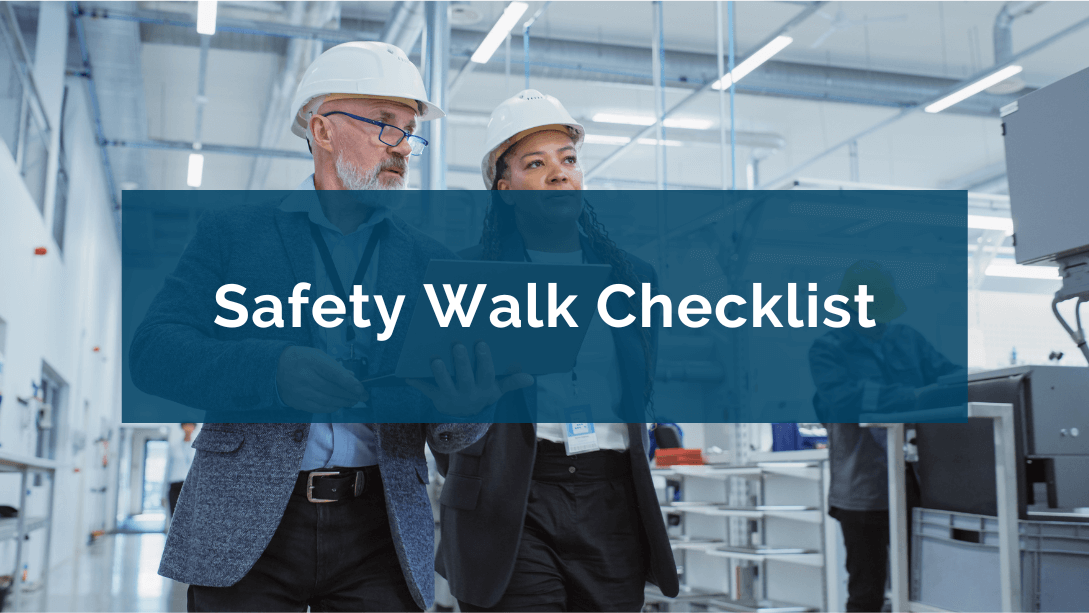What is a safety walk checklist?
A safety walk checklist, or safety walkthrough checklist, is a tool that supports effective and thorough safety walkthroughs. It allows the person performing the safety walk to observe work to identify and assess health and safety-related conditions, behaviors, and systems. It ensures that all critical hazards are checked and covered in the work environment.
The purpose of the safety checklist is to detect deviations, potential hazards, and risky situations early, so that actions can be quickly taken to prevent incidents or accidents.
Usage frequency
Depending on the level of risk and the industry, safety walks may be carried out daily, weekly, or monthly. Most prevention organizations recommend using a checklist alongside these regular safety walks, especially when significant changes occur in the work environment, such as installing new machinery.
Some checks are integrated into daily or weekly safety walkthroughs, while others are carried out during ad hoc inspections or after an incident.
Key stakeholders
Developing the content for a useful, effective checklist requires the collaboration of several distinct forces:
-
WHS managers or designated safety officers often play a key role in the initial design of the safety checklist, drawing on safety regulations, risk analysis results, and floor observations.
-
Supervisors, frontline managers, and team leaders actively participate in defining the elements to include, as they are familiar with the operational realities, and safety issues and hazards specific to their department.
-
The members of the WHS committee provide a cross-functional perspective and ensure that the safety walk checklist covers all aspects of safety.
-
Employees can help spot hazards to monitor as they are directly exposed to them on a daily basis.
Digital tools for checklist creation
Applications designed to create digital checklists – such as UTrakk Daily Management System (DMS) – are the best solutions for structuring, tracking, and leveraging data and information from safety checklists. They enable direct input on tablets or mobile devices, ensure real-time data synchronization, and provide visual dashboards that facilitate gap analysis and the creation of corrective actions.
The UTrakk platform helps to:
-
Standardize safety walk checklists with consistent and relevant questions based on department or workstation.
-
Collect and centralize floor data in real time during regular safety walks, or safety inspections and audits.
-
Quickly identify discrepancies with interactive input features.
-
Instantly share results with decision-makers and other relevant stakeholders via links or downloads.
Why is a safety walk checklist so important for workplace safety?
Today, the importance of worker health and safety is undeniable. A WHS checklist is equally essential – it helps closely monitor safety measures, behaviors, and work practices, ensuring risks are addressed and key benefits are realized.
Enhanced safety
Conducting a safety inspection blindly would not be very useful. By methodically covering all critical areas – from the most hazardous to the less ones – the checklist provides a clearer view of safety hazards in the workplace.
A well-designed safety checklist acts as a safety net that helps prevent workplace hazards.
Traceability and compliance
Each completed box is a formal proof that a comprehensive safety program for monitoring practices and standards is implemented within the company. In the event of an external audit, an inspector's visit, or a post-incident investigation, this traceability guarantees effectiveness of WHS processes and practices. The safety walkthrough checklist also demonstrates that the organization is committed to complying with its regulatory obligations and protecting its workers.
Managerial vigilance
By incorporating a safety checklist into their regular floor tours, frontline managers develop an active presence on the floor, sharpen their observation skills, and can spot the early signs of potential hazards more quickly. They anticipate rather than react.
Continuous improvement
Beyond hazard identification, a safety walk checklist helps highlight trends and recurring process anomalies. It contributes to continuous improvement, as it creates alignment between workplace observations and the action plans to implement.
Employee engagement
Involving operators in creating or using a safety checklist means making room for dialogue. It’s about recognizing and valuing their experience, raising attention to health and safety matters, and increasing their sense of belonging to a shared safety culture.
Key control points to include in a safety walk checklist

Workstations
-
Cleanliness of the premises (dust, leaks, or hazardous materials on the floor)
-
Adequate lighting
-
Temperature and ventilation
-
Ambient noise
-
Clear and tidy spaces
Equipment and machinery
-
Safety devices (covers, emergency stops)
-
Up-to-date facility and equipment maintenance
-
Abnormal noise or vibration
-
Employee training on the use of various equipment
Traffic and signage
-
Clearly marked routes (walking surfaces, routes for vehicles)
-
Clear and visible signage
-
Unobstructed emergency exits
-
Evacuation plan displayed
Hazardous products
-
No toxic emissions (gases, vapors)
-
Chemicals properly labeled
-
Safe storage and waste containers
-
Accessible technical data sheets
Behavior and practices
-
Use of personal protective equipment (PPE) (safety glasses, helmets, vests)
-
Compliance with safety standards
-
Safe postures and movements
-
Clear communication about hazards
Work processes
-
Compliance with safety practices
-
Adequate coordination between production stages
-
Line change management including risk assessment
Emergency procedures
-
Accessibility of first aid equipment (first aid kits, defibrillators)
-
Knowledge and understanding of evacuation plans (emergency exits) and safety protocols
-
Functional alarms, warning devices, and sprinkler heads
Documentation and compliance
-
Mandatory displays of safety procedures
-
Up-to-date incident log
-
Documented health and safety training
How to create a comprehensive safety walk checklist for flawless monitoring
1. Identify hazards specific to each workstation and work area
The first step is careful observation. Analyze past incidents, near misses, existing risk assessments, internal audits, and employee feedback.
The goal is to identify potential hazards in areas, equipment, or behaviors that could compromise safety.
2. Break down observations into categories
Categorize identified hazards by theme (workstations, equipment, traffic, etc.) to properly structure the safety walk checklist. Such categorization helps cover all safety issues and makes the checklist more readable.
3. Write visible control points
Choose positive, precise, and verifiable statements, such as “Fire extinguishers are accessible, inspected, and comply with fire safety standards” instead of “Check fire extinguishers.” Avoid vague or subjective terms that can be misinterpreted.
4. Assign a risk level to each control point
Not all control points are equal. Assign priorities – high, medium, low – based on risk levels. This helps prioritize corrective actions and start where there’s an urgent need.
5. Ask stakeholders to validate and enrich content
Include frontline managers, members of the safety committee, and operators in creating a safety checklist template. Their recommendations will make it better suited to the realities of operations in the workplace environment.
6. Establish a system for continuous monitoring and update
The safety walk checklist must evolve with new machines, process changes, or feedback. Assign a person who will be responsible for its periodic review.
Safety walk checklist: More than a tool, a source of operational excellence
The true power of a safety walk checklist lies in its ability to act as a magnifying glass, highlighting overlooked details and enabling an active assessment of workplace safety that turns observations into corrective actions.
It serves as both a tool for dialogue and a vehicle for accountability. It connects people, processes, and practices, while promoting a proactive and responsible approach to WHS. In this sense, the safety checklist is more than a simple control tool; it reflects an organization’s ability to understand health and safety hazards in the work environment and respond effectively to eliminate them.
In an industry where performance and safety are inseparable, the safety checklist becomes an essential guide for safety walks and plays a key role in driving operational excellence.










